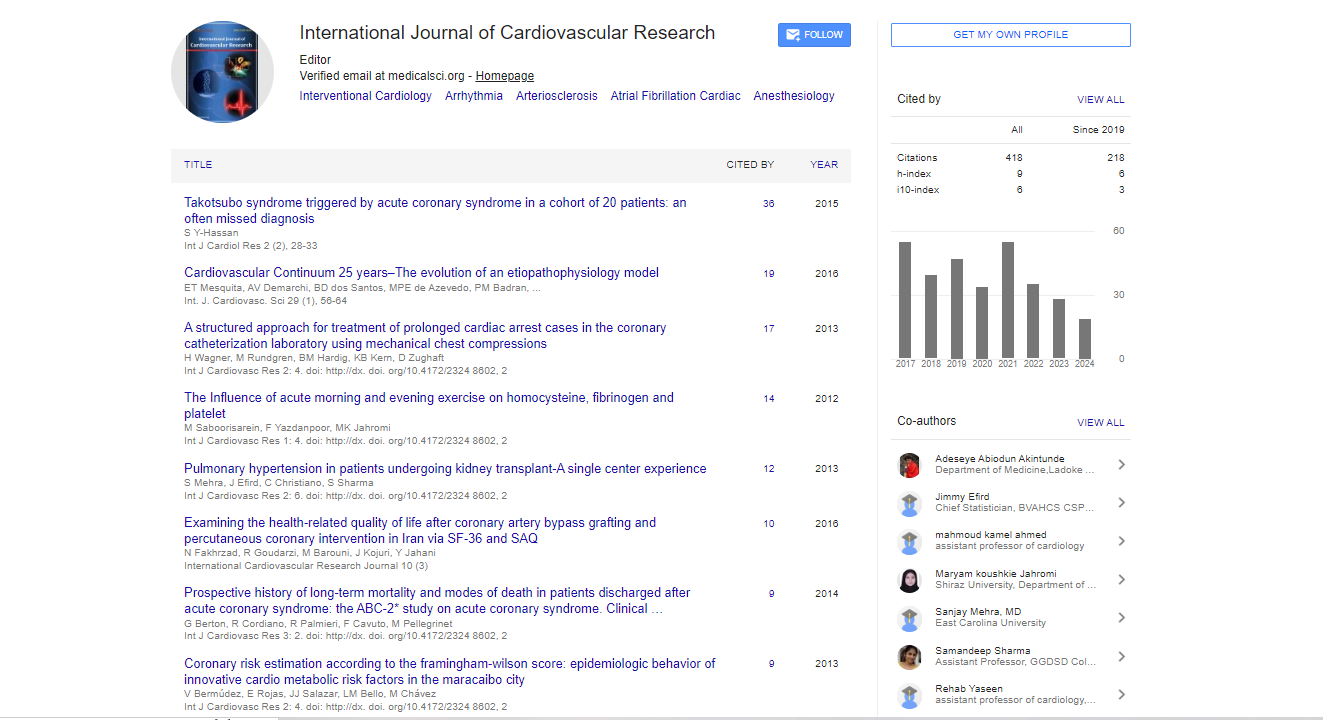Short Communication, Icrj Vol: 10 Issue: 8
Endoplasmic Reticulum Stress, Inflammation, Oxidative Stress and Neutrophil Extracellular Traps in Cardiovascular Diseases
Author Name: Chiara Mozzini
Abstract
endoplasmic reticulum (ER) stress, oxidative stress and inflammation in cardiovascular diseases. Insults interfering with ER function lead to the accumulation of unfolded and misfolded proteins in the ER. An excess of proteins folding in the ER is known as ER stress. This condition initiates the Unfolded Protein Response (UPR). When the UPR fails to control the level of unfolded and misfolded proteins, ER-initiated apoptotic signalling is induced. Moreover, the role of the protective nuclear erythroid-related factor 2 (Nrf2)/Antioxidant- Related Element (ARE) and the activation of the pro-inflammatory Nuclear Factor-Kappa B (NF-kB) are analysed. Current literature data are presented, focusing on three topics of related pathologies: atherosclerotic plaque, coronary artery disease and diabetes. Moreover, current evidence suggests the likelihood of a link between venous thromboembolism (VTE) and atherosclerosis, although they have been traditionally considered as different pathological identities. The contribution of neutrophils to human atherogenesis has been underestimated, if compared to their contribution established in VTE.
Introduction : To summarize the understanding of the interrelated roles of endoplasmic reticulum (ER) stress, oxidative stress and inflammation in cardiovascular diseases. Insults interfering with ER function lead to the accumulation of unfolded and misfolded proteins in the ER. An excess of proteins folding in the ER is known as ER stress. This condition initiates the Unfolded Protein Response (UPR). When the UPR fails to control the level of unfolded and misfolded proteins, ER-initiated apoptotic signalling is induced. Moreover, the role of the protective nuclear erythroid-related factor 2 (Nrf2)/Antioxidant- Related Element (ARE) and the activation of the pro-inflammatory Nuclear Factor-Kappa B (NF-kB) are analysed. Current literature data are presented, focusing on three topics of related pathologies: atherosclerotic plaque, coronary artery disease and diabetes. Moreover, current evidence suggests the likelihood of a link between venous thromboembolism (VTE) and atherosclerosis, although they have been traditionally considered as different pathological identities. The contribution of neutrophils to human atherogenesis has been underestimated, if compared to their contribution established in VTE. This is due to the major importance attributed to macrophages in the plaque destabilization. Nevertheless, recently, the role of neutrophils in atherogenesis deserves increasing attention. In particular, Neutrophil Extracellular Traps (NETs) are net-like chromatin fibres which are released from dying neutrophils. The death of neutrophils with NETs formation is called NETosis. During activation, neutrophils produce Reactive Oxygen Species (ROS), through the activation of Nicotinamide Adenine Dinucleotide Phosphate (NADPH) oxidase. The main function of NETs is trapping and killing pathogens. However, NETs formation has been observed in various chronic inflammatory diseases, autoimmune diseases, vasculitis, lung diseases, cancer and VTE. Recent studies suggest that NETs formation could contribute also to atherosclerosis progression. New data report the presence of NETs in the luminal portion of human atherosclerotic vessels and coronary specimens obtained from patients after acute myocardial infarction. Programmed death mechanisms in atherosclerosis such as apoptosis, efferocytosis and also NETosis, share common features and triggers. If defective, they can lead the cells to a switch from programmed death to necrosis, resulting in the release of pro-atherogenic factors, accumulation of cell debris and progression of the disease. This talk aims to analyse the emerging role of neutrophils focusing on NETosis and oxidative stress burden in orchestrating common mechanisms in atherosclerosis and thrombosis.
 Spanish
Spanish  Chinese
Chinese  Russian
Russian  German
German  French
French  Japanese
Japanese  Portuguese
Portuguese  Hindi
Hindi 



